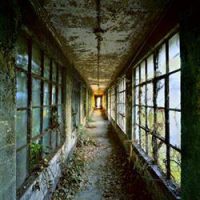“To me, this is the most exciting moment in the history of photography. The potential to explore things that we’ve never done in a still photograph are so great. . . I’ve been very conscious of using new technologies in the medium to push the medium outward …I find that by creating images that have an inherent beauty, people will look at them for just a second, and if I get you for just a second, then I think I can make you think a little deeper about what I’m showing you . . . The power of the single image is the way.”
[Stephen Wilkes in conversation with Peter Simpson of the Ottawa Citizen, prior to his artist exchange events in Ottawa, Canada, in November of 2015]
Art in Embassies and the Embassy of the United States in Ottawa, in partnership with the National Gallery of Canada (NGC), welcomed renowned American photographer Stephen Wilkes for the fourth lecture in the Contemporary Conversations series on November 19, 2015.
Contemporary Conversations brings internationally recognized American artists to Canada for a series of public lectures at the NGC intended to stimulate conversation around issues that transcend borders, and topics that inspire, teach, and create connections. Photographs by Wilkes were also on display as part of the Art in Embassies exhibition; Wilkes’ photograph Corridor # 9, Island 3, Ellis Island (1998) was featured at the U.S. Embassy Residence and Presidential Inauguration, Day to Night (2013), was hanging at the U.S. Embassy.
While in Ottawa, Wilkes was able to reach numerous audiences; he was a guest on the CBC radio program All in a Day, as well as CTV’s Morning Ottawa. He also participated in an interactive conversation held at the U.S. Embassy with an audience made up primarily of post-secondary students in international relations, political science, and photography. The discussion focused on the theme of “Photography as an Agent for Change.” The Contemporary Conversation at the NGC auditorium that same evening continued this theme, which was explored in more detail during the discussion between Stephen Wilkes and U.S. Ambassador to Canada, Bruce Heyman, before an engaged audience. The talk was simulcast to the Gallery’s lecture hall for the overflow crowd.
1
00:00:09,008 –> 00:00:14,487
It’s so good to have you here in Ottawa and have you part of the Contemporary Conversations
2
00:00:14,559 –> 00:00:15,587
series that we are doing.
3
00:00:15,096 –> 00:00:23,114
And you know, to have an iconic
photographer, artist is a real treat for us.
4
00:00:24,022 –> 00:00:29,025
Steve you’ve really touched me personally
with a lot of your work.
5
00:00:29,066 –> 00:00:35,124
We’re here, though, right here with Ellis Island and did your work really begin with Ellis Island?
6
00:00:36,025 –> 00:00:40,121
Did the impact of Ellis Island
really change you?
7
00:00:41,042 –> 00:00:47,094
In particular, this photograph was a real game changer. The ability to make a
8
00:00:47,095 –> 00:00:54,109
photograph that would inspire people to
want to give and save a place like Ellis Island.
9
00:00:55,009 –> 00:01:00,012
10
00:01:00,012 –> 00:01:05,085
Understanding that there was history in
these walls, in these rooms very much
11
00:01:05,085 –> 00:01:11,096
forgotten history. And so I discovered
through Ellis that I could take not
12
00:01:11,096 –> 00:01:14,164
just photographs that had beauty,
intrinsic beauty but that had a subtext that
13
00:01:15,064 –> 00:01:19,064
was humanity in many of the rooms I
photographed. And that was a very powerful
14
00:01:19,064 –> 00:01:25,183
learning lesson because it made me
realize that my work could actually force
15
00:01:25,759 –> 00:01:31,380
change and create social change. And it was through that experience that I began to
16
00:01:31,038 –> 00:01:36,116
have a real need to want to experience
that every time I created art. That there
17
00:01:37,016 –> 00:01:42,060
was, it reached a different level
for me as an artist. You know, that I
18
00:01:42,006 –> 00:01:48,094
could bring the things that were part of
my social consciousness and share that with others.
19
00:01:49,006 –> 00:01:53,030
So where are we here? What is this this?
20
00:01:54,000 –> 00:01:59,086
This corridor number nine is where all the doctors and nurses would travel back and forth
21
00:02:00,006 –> 00:02:07,185
to get to various infectious disease wards. So it is very special and powerful meaning in terms of the context
22
00:02:07,239 –> 00:02:08,315
of what occurred there.
23
00:02:09,179 –> 00:02:11,267
And incredible powerful in terms how you caught light.
24
00:02:12,002 –> 00:02:16,100
The right side of the photograph,
everything was lit, brightly glowing, but
25
00:02:17,018 –> 00:02:21,043
everything was dead and left side was
was dark and everything was living. And
26
00:02:21,043 –> 00:02:25,962
suddenly this metaphor for me came. It’s
so clear that this place was about life
27
00:02:26,349 –> 00:02:30,410
and it was about death. And then the glow at the end
28
00:02:30,041 –> 00:02:35,047
reinforced that you’re traveling
someplace else, and I think that’s what
29
00:02:36,001 –> 00:02:37,073
the immigrant experience was.
30
00:02:37,073 –> 00:02:39,099
So you effected change, you did this whole series
31
00:02:40,008 –> 00:02:47,167
with Ellis Island. You then went on to
Katrina and Sandy, and then you did this
32
00:02:47,239 –> 00:02:53,307
new series, Day to Night, which is really
prominent your work now. How did you do that?
33
00:02:54,002 –> 00:02:58,036
The concept is that I, as technology evolved, I wasn’t interested in
34
00:02:58,036 –> 00:03:02,041
just using tools to reproduce the same
pictures I made with film.
35
00:03:02,086 –> 00:03:06,120
I saw this is an opportunity to push the
medium of photography outward.
36
00:03:11,067 –> 00:03:16,150
And I began to explore the idea of
changing time in a single photograph so
37
00:03:17,005 –> 00:03:21,064
I photograph from a single point of view for 15 hours on average and I shoot
38
00:03:22,009 –> 00:03:28,037
literally 1500 images, edit them down to
about 50, and then I decide where day
39
00:03:28,037 –> 00:03:32,114
begins and night ends. And on that what I
call the time vector all the best
40
00:03:33,014 –> 00:03:38,020
moments of the morning, midday, afternoon, and evening gets seamlessly get layered together
41
00:03:38,002 –> 00:03:44,060
into one single photograph. I’m trying to
put a face on time. I’m actually looking
42
00:03:44,078 –> 00:03:48,117
at something that we all feel
intuitively but never to get our hands around.
43
00:03:48,819 –> 00:03:49,826
That’s exciting. Yes.
44
00:03:50,519 –> 00:03:51,531
Thanks again for being here.
45
00:03:51,639 –> 00:03:53,639
Thank you so much. It’s always a pleasure.
46
00:03:53,639 –> 00:03:54,683
Nice to see you.
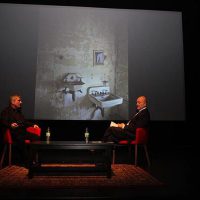
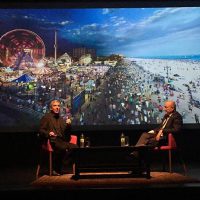
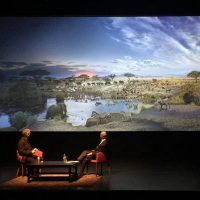
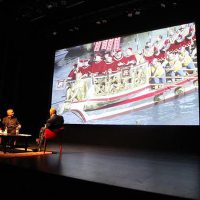
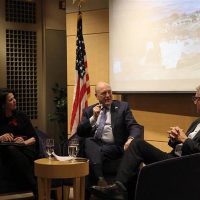
![Stephen Wilkes, Presidential Inauguration, Day to Night, 2013, Archival Digital Type-C print on Acrylic [Edition #4/30], Courtesy of the artist, Westport, Connecticut Stephen Wilkes, Presidential Inauguration, Day to Night, 2013, Archival Digital Type-C print on Acrylic [Edition #4/30], Courtesy of the artist, Westport, Connecticut](https://uss58003.s3.amazonaws.com/wp-content/uploads/2016/11/Stephen-Wilkes-Presidential-Inauguration-Day-to-Night-2013-200x200.jpg)
